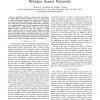Free Online Productivity Tools
i2Speak
i2Symbol
i2OCR
iTex2Img
iWeb2Print
iWeb2Shot
i2Type
iPdf2Split
iPdf2Merge
i2Bopomofo
i2Arabic
i2Style
i2Image
i2PDF
iLatex2Rtf
Sci2ools
GLOBECOM
2008
IEEE
2008
IEEE
Modeling Mobility-Assisted Data Collection in Wireless Sensor Networks
—Exploiting mobility to enhance the performance of wireless sensor networks (WSNs), in terms of connectivity, coverage, and lifetime elongation, has recently been the focus of several research studies. Mobility was adopted in two different ways; either using a network of mobile sensor nodes or deploying a few supplementary special mobile elements, usually referred to as mobile agents to help enhance connectivity and coverage. Different modes of operation (roles) were assigned to mobile agents including being a data relay, data collector, and data sink. In this paper we use a closed queueing network to model mobility and then evaluate data latency under all those roles. The proposed model provides powerful means to understand the effect of different parameters, like velocity and number of mobile agents as well as their movement strategy, on data latency.
| Added | 29 May 2010 |
| Updated | 29 May 2010 |
| Type | Conference |
| Year | 2008 |
| Where | GLOBECOM |
| Authors | Hisham M. Almasaeid, Ahmed E. Kamal |
Comments (0)

